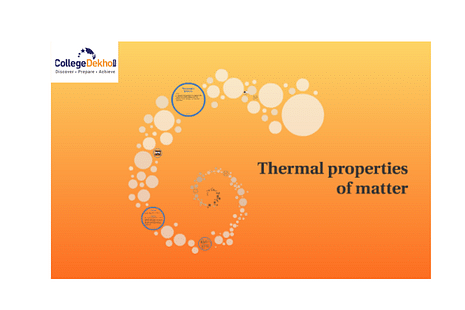
Thermal Properties of Matter: Matter is found in three states: Solid, Liquid and Gas. These states are composed of atoms or ions or molecules packed in a certain lattice and possess some potential energy. The classification of the matter is done on the basis of internal arrangement of atoms. Matter in which the particles are tightly packed is known as Solid. In liquids, the arrangement of the particles is less consolidated than that in solids. They are loosely packed and acquire the shape of the container in which they are kept, up to their volume. At last, matter in which the particles are least tightly packed is gas. Gases possess the highest potential energy due to the mobility of their composing particles.
Apart from their building blocks, there are also other parameters which define the properties of matter. These include their mechanical properties, Chemical properties, Physical properties, Thermal Properties, etc. In this article, we will be unleashing the Thermal Properties of Matter. Read the article to learn more about the thermal state of matter.
Thermal Properties of Matter: Definition
As we know, “Temperature” is one of the most fundamental properties of matter. It defines the thermal stature of matter. The properties affiliated to the thermal state of a body includes thermal conductivity, thermal expansion, heat capacity, etc.
These thermal properties make the matter capable of conducting the heat. On the passage of heat through them, the matter exhibits the Thermal Properties. And it is due to the virtue of thermal properties that the different materials act differently under the influence of heat. In addition to this, the Thermal properties account for the chemical reactivity of the matter when they are addressed to heat.
Heat
Heat is a form of energy which is also responsible for the existence of life on earth. Heat is the primary source of energy which human beings use in various ways. These include cooking, running engines, keeping themselves warm, etc. Heat, as an energy, also plays a crucial role in the natural processes such as rainfall, oceanic current development, change of seasons and so on.
With the increase in a body’s temperature, molecules or atoms’ vibrations increase. These vibrations are then transferred from one part of the body to another. The measure of energy with which the molecules vibrate in a system is termed as heat stored in that object.
Temperature
The measurement of the degree of hotness or coldness of a body is defined on the basis of temperature. And as it has already been mentioned that the thermal status of the body completely depends upon the temperature. Our senses also provide the qualitative indication of the temperature.
Heat, on the other hand, may be defined as that form of energy because of which, a body or an object experiences an increase or decrease in its internal energy [when the body or the object is in a static condition with no external work done either on or by the body/object]. This flow of heat between two different bodies happens due to the temperature difference between them. Joule (J) is the S.I. unit of heat. For instance, in order to increase the temperature of 1 gram of water from 14.5°C to 15.5°C, the amount of heat that is required is 1 Calorie, where 1 Calorie = 4.18 joules.
Thermal Expansion
We know that the volume of matter is directly proportional to the heat supplied to it. As soon as the heat is supplied to a substance, it starts to expand and its shape tends to change. In other words, an object expands on heating. This property, due to which matter expands upon providing heat, is known as thermal expansion.
The real life examples to justify thermal expansion lies all around us. Some of the most common examples are the lengthening of electric wires in summers while their shrinkage in winters, small gaps between the railway tracks due to heat, the length of second hand of the clock changing with season and so on.
Thermal expansion of solids, liquids and gases
Thermal expansion is commendable in gases and liquids whereas it is marginal yet noticeable in solids. The rate at which the matter expands on exposure to heat is known as coefficient of expansion. In solids, thermal expansion is described in terms of change in length, height and thickness. In fluids i.e. liquids and gases, the thermal expansion takes in the dimensions of volume. However the expansion is not uniform in solids. The expansion is more in the region of direct contact of heat. Such an expansion is known as Non isometric expansion.
Thermal expansion of solids, liquids and gases is characterised by the points mentioned below:
- Linear Expansion: It is the increase in the length of the solid. Example: If we will consider one rod where the length of the rod is l, and we will increase the temperature of a rod by a small amount. So Linear Expansion is given by:
- The Coefficient of linear expansion of the given solid is denoted as a. then for a unit is per degree Celsius) in the CGS and in the SI system it is per kelvin K-1.
- Volume Expansion: Volume expansion is defined as the increase in the volume of the solid on heating. With a change in temperature ∆t the change in volume of a solid is given by ∆v=Vy∆t where the coefficient of volume expansion is y.
-
Area or superficial Expansion: Superficial expansion is defined as the increase in surface area of the solid on heating. If you consider at 00C area of a solid is A0 then its area at t0c is given by: A0(l+βt). Unit of β is 0C-1 or K-1. Where β is known as the coefficient of superficial expansion.
6α = 3β = 2γ
This equation shows the relationship between α is the linear expansion, β is the superficial expansion, and volume expansion. These three coefficients of expansion for a given solid are not constant because these values totally depend on the temperature. Examples of thermal expansion in our daily life are thermometers, riveting, on wooden wheels fixing metal tires etc.
Also Read:
- Physics Class 12 Units and Measurements
- Physics Class 12 Motion in a Straight Line
- Physics Class 12 Laws of Motion
- Physics Class 12 Mechanical Properties of Fluid
- Physics Class 12 Mechanical Properties of Solid
Anomalous Expansion of Water
An abnormal property of water due to which it expands rather than contracting as its internal temperature is decreased from 4oC to 0oC. In other words, the density of water increases with a decrease in temperature. This special property of water is known as Anomalous Expansion of Water. The graph provided below will indicate this property of Anomalous Expansion of water.
The graph suggests that the thermal tendency of water remains natural or conventional and its density keeps increasing till its temperature reaches 4oC . But , Now as we further cool the water i.e decrease its temperature, a gradual increase in its density is observed. So at 4oC , water gains the maximum density and contrary to the natural facts of heat and density relation, water expands even while decreasing its temperature.
The density becomes less and less as it freezes. To account for the above given property, it can be stated that due to formation of open crystal structures by the molecules of water when they are in solid form.
Specific Heat Capacity
When a body is heated, its temperature rises. Experiments show that the amount of heat given to a body is directly proportional to the mass of the body and the temperature-rise. Thus, if an amount of heat Q given to a body of mass m raises its temperature by Δ T , then
Q ∝ m X ΔT
Q =c X m X ΔT ,
Where c is a constant depending upon the material of the body. It is called the ‘Specific Heat’ of the material. From the above equation, we can write
Taking it further, we can define the “Specific Heat Capacity” as the amount of heat energy required to change the temperature of the body by 10C.
Molar Specific Heats of Gases (Cp and Cv)
If instead of considering 1 gram of gas, we consider 1 gram-molecule (1 mole) of the gas, then the specific heats are called ‘molar specific heats’ of the gas.
The molar specific heat of a gas at constant volume is defined as the amount of heat required to raise the temperature of 1 mole of the gas through 10 C ( or 1 K), when its volume is kept constant. It is denoted by Cv. If M is the molecular mass of the gas, then 1 mole = M gram. Therefore
Cv = Mcv
Similarly, the molar specific heat of a gas at constant pressure is defined as the amount of heat required to raise the temperature of 1 mole of the gas through 10 C ( or 1 K), when its pressure is kept constant. It is denoted by Cp.
Again, Cp = Mcp
Calorimetry
Matter and Energy comprises the Universe. Atoms and Molecules make up the matter and energy invariably brings these particles in motion by altering its internal stability. This movement in the constituent particles of the matter generate a type of energy known as internal thermal energy. Heat is present in all matter, including the coldest voids of space. In this article, we discuss the method of measuring the heat transfer that occurs within a chemical reaction or other physical processes, and this method is known as calorimetry.
So based on the internal The act or science of measuring the changes in the state variables of a body in order to calculate the heat transfer associated with changes of its states such as physical changes or phase transitions under specific conditions is known as calorimetry. Calorimetry is performed with the help of a calorimeter.
Thermal conductivity & Heat transfer (Conduction, Convection and Radiation)
The flow of heat from one body to another, or from one place to another is called ‘transmission of heat’. There are three methods of heat-transmission: conduction, convection and radiation.
- Conduction: Whenever there is a temperature difference between different parts of a body, then the particles of the body at a higher temperature give heat by mutual contact to the particles at lower temperature. Thus, heat flows from the part at higher temperature to the part at lower temperature. This process of heat transmission in which the particles of the body do not leave their positions is called ‘Conduction’. For eg. When one end of a metallic bar is kept on fire, then heat flows by conduction from the hot end of the bar to the cold end. As a result, the other end also becomes hot. In solids, the transmission of the heat takes place by conduction.
- Convection: Whenever the temperature of the lower region in a fluid becomes higher than the temperature of the upper region, the density of the fluid in the lower region becomes less than that in the upper region. Hence particles of the fluid in the lower region begin to rise and their places are occupied by the particles in the upper region. The process continues until the temperature of the whole fluid becomes the same. This process of heat-transmission in which the particles of the fluid moves is called ‘Convection’. The water in a vessel placed on fire becomes hot by convection. Convection takes place only in liquids and gases.
- Radiation: Heat is also transmitted in the form of electromagnetic waves from a hot body. This is called ‘radiation’. It does not require any medium. If present, then the medium does not become hot. Heat from the sun reaches the earth by radiation.
Heat - Transmission by conduction and convection takes place slowly, but by radiation heat is transmitted with the speed of light. Furthermore, in conduction and convection the path of heat-transmission may be zig-zag, but the path of radiation is a straight line. This is why we can protect ourselves from the heat-rays of the sun by using umbrellas.
Qualitative Ideas of Black Body radiation
The concept of an ideal black-body plays a vital role in studying the thermal state of matter in terms of thermal radiation and electromagnetic radiation energy transfer in all wavelength bands. The black body is specialised by its name due to the fact that it absorbs 100% of the visible light and reflects nothing. The black body, being an ideal absorber of the radiations, is preferred as a standard with which the absorption of real bodies is compared. The uniqueness lies in the fact that the black body releases the utmost quantity of radiation and, consequently, it is used as a standard for comparison with the radiation of real physical bodies.
Apart from absorbing the radiation completely, the black body has certain important properties as well. For example, if a black body is placed inside a completely insulated cavity of arbitrary shape at a constant temperature, whose walls are also formed by an ideal black body at a specific constant temperature. The condition being the initial temperature of the outside and the inside black body is different. After a while the black body and also the closed cavity will have a standard equilibrium temperature. Under equilibrium situations it’s necessary for the black body to emit exactly the same amount of radiation as it absorbs.
Let us contemplate a system comprising a black body within a closed cavity that is at thermal equilibrium. The wall of the cavity has a peculiar property, it can emit and absorb radiation within a narrow wavelength band only. Being an ideal energy absorber, the black body absorbs the entire incident radiation in this wavelength band. Hence, the black body is an ideal emitter for any wavelength. It also has emissive ability and absorbing ability.
Quick Links for Preparation:
Wien's displacement law
“The black-body radiation curve of bodies at different temperatures indicates a peak at different wavelengths and this phenomenon is inversely proportional to the temperature of the body.” This is the statement of Wien's displacement law. Further, it is also stated that the Planck radiation law causes this shift in the peaks, which describes the spectral brightness of black-body radiation as a function of wavelength at any given temperature.
The mathematical expression of the Wein’s displacement law is as follows:
Where, T is the temperature and b is the Wein’s displacement constant with a value 2.897771955...×10−3 mK
Lets learn about the Wein’s displacement constant
It defines the relationship between the wavelength and the thermodynamic temperature of the black body. It is a product of the temperature and wavelength of the black body, which grows shorter as the wavelength reaches a maximum with temperature.
Stefan’s Law
The Stefan Boltzmann law states that the quantity of radiation released per second from a unit area A of a black body at absolute temperature T is directly proportional to the fourth power of the temperature.
u/A = σT4 . . . . . . (I)
where σ is the Stefan’s constant whose value is 5.67 × 10-8 W/m2 k4
A body that is not a black body absorbs and hence emit less radiation, given by equation (1)
For such a body, u = e σ AT4 . . . . . . . (II)
where e is the emissivity whose value ranges between 0 to 1.
With the surroundings of temperature T0, net energy radiated by an area A per unit time.
Δu = u – uo = eσA [T4 – T4]. . . . . . (III)
Stefan Boltzmann Law relates the temperature of the blackbody to the amount of power it emits per unit area. The law states that;
“The total energy emitted/radiated per unit surface area of a blackbody across all wavelengths per unit time is directly proportional to the fourth power of the black body’s thermodynamic temperature. ”
Derivation of Stefan Boltzmann Law
Integrating Planck's radiation formula helps to obtain the total power radiated per unit area over all wavelengths of a black body. Thus, the radiated power per unit area as a function of wavelength is:
Where,
- P is Power radiated.
- λ is the wavelength of emitted radiation.
- A is the surface area of a blackbody.
- c is the velocity of light
- h is Planck’s constant
- T is temperature
- k is Boltzmann’s constant.
On equating Stefan Boltzmann equation, we get:
Integrate both sides with respect to λ. Then, apply the limit as follows:
On separating the constant, the integrated power becomes:
On substituting, the calculation becomes easy as:
Therefore,
On Substituting the values in equation (1)
The above equation can be comparable to the standard form of integral:
Thus, substituting the above result, we get,
On further simplifying, we get,
Thus, we arrive at a mathematical form of Stephen Boltzmann law:
Where,
This derivation of the planck's radiation formula successfully explained the behaviour of gases at low temperature which the classical mechanics failed to do!
















Similar Articles
DHE/SAMS Odisha +3 Admissions 2025: Registration, Eligibility Criteria, Selection Process, Seat Allotment, Merit List
B.Ed Admission 2025: Dates, Application Form, Eligibility, Selection Process, Fees, Top Colleges
List of Documents Required to Fill UGC NET 2024 Application Form: Image Upload, Specifications
REET Syllabus 2025 for Level 1 and 2: Download Subject-wise PDFs, Exam Pattern
Karnataka B.Ed Selection List 2024: Date, Seat Allotment Result Link, PDF Download
TS TET 2024: Exam Dates (Out), Registration (Closed), Admit Card, Results